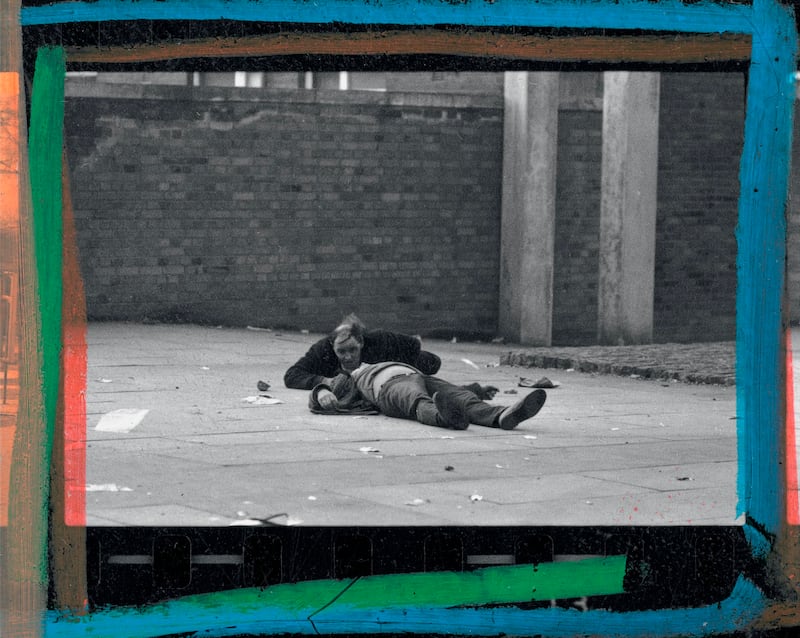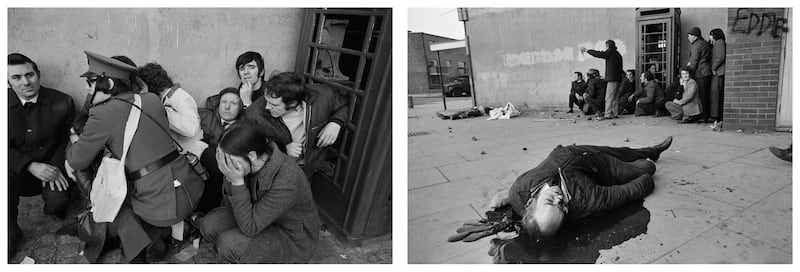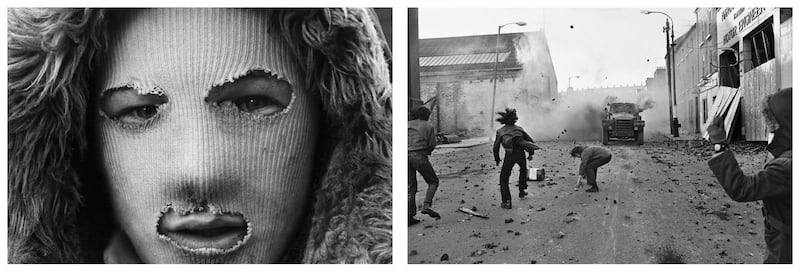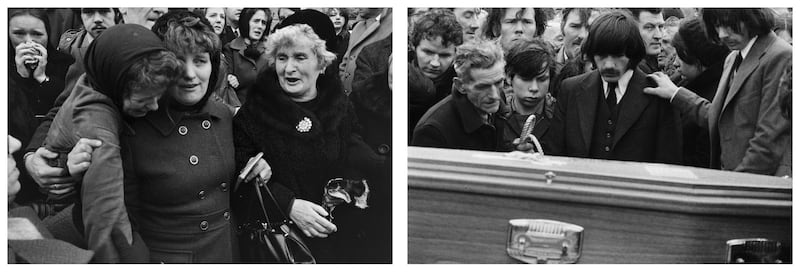A group of men crawl along the ground, trying to find shelter from the shooting. Eleven people have been killed or mortally wounded since the British army’s Parachute Regiment opened fire in Derry’s Bogside less than 10 minutes ago.
A young French photographer, Gilles Peress, takes their picture as they crouch low to avoid the bullets. One of them, Patrick Doherty, has a handkerchief tied over his mouth and nose to protect himself from CS gas; it is the only splash of white in the black and grey of the photograph.
As they disappear from view, Peress decides to follow them. When he sees them again, moments later, Doherty is lying on his back on the ground. “He was clearly extremely badly wounded if not dead,” Peress would later tell the Saville Inquiry into Bloody Sunday. “There was a man behind Doherty, crawling on his belly towards Doherty shouting something with an expression of shock on his face.”


He describes the amazement of the Magnum bureau chief in Paris when he developed the photos. “He sees the picture of Patrick Doherty lying down and following his crawling under the passageway and he’s lying dead, and he said, ‘for God’s sake, we have a picture of a man who’s unarmed and shot dead’.”
Such is the significance of Peress’ pictures; not only do they convey with terrifying immediacy the horror and confusion of Bloody Sunday, but they also depict that – contrary to the British army’s account – the victims were unarmed civilians. Peress would make this point, forcefully, at the now-discredited Widgery tribunal and at the Saville Inquiry. “I didn’t see a man with a gun,” says Peress. “I saw people alive, no gun, and then dead.”
It was a turning point; “in those kinds of situations I don’t exist... I am on the other side of the camera, to a large extent there is a part of me that’s transparent.”
When a soldier shot at him “I turned the corner, showed him my camera, he shot and there was an impact [in the wall behind]... he missed my head by this much, but there is no feeling that I remember.”
“When I got to Barney McGuigan and when the priest came and gave him extreme unction I was in tears but I was still shooting pictures.”

Bloody Sunday, he says, was “an event that really changed the North... the night after in the flats [in the Bogside] you had lines of guys wanting to become [IRA] volunteers. They created the IRA that day.”
For Peress, it also created a lifelong connection to, and fascination with, Northern Ireland; he would return again and again, not least at the time of the hunger strikes in 1981 and the first IRA ceasefire in 1994.
"The impact of the colonial powers and especially of the United Kingdom on the world, that grabbed me, and the fact that the Irish all along had resisted, that also grabbed me. So that's the reason why I got involved and I came back and back and back."

A remarkable two volume, 2,000-page photobook, Whatever You Say, Say Nothing (accompanied by a separate explanatory volume, Annals of the North) by Peress and Chris Klatell, published last year, aims to describe the "totality" of life in the North "in all its intricacies, to describe days where there are events and people die, and the boring days... not journalism but a sense of what it meant to live in that place".
Hence there are photographs of foxhunts and nights out and people in fancy dress, just as there are also photographs of masked paramilitaries and teenage rioters and burning buses. Peress explains that “in a place like the North, time is not any more linear; anniversaries, protests and the will of history itself means that lives unfold within a cyclical structure of time, it’s helicoidal.”
The battle now at stake, he says, is over the writing of history. He recalls a mural on the Springfield Road in Belfast, "which had a woman pulling down a mask saying the victors write history... When I think about Bloody Sunday, it's part of a train of thought that has to do with this writing of history."

He had hoped to return to Derry for the 50th anniversary of Bloody Sunday, but this has been disrupted by Covid-19. His next book will comprise pictures taken since 1994, including those on his most recent trip, when he “did the whole Border... I started in Derry and went all the way, including those insane moments in Cavan where every 15 yards you have another chunk of the Border.”
Its title will be taken from a French phrase, between dog and wolf, which describes the light at the time of day “when it’s not day any more and it’s not yet night... where you don’t know if you’re looking at a dog or looking at a wolf”.
That is where the North is now, says Peress. “You don’t know where you are, you’re between dog and wolf.”


















